This article is based on a poster originally authored by James Craswell, Holly Madden, Thomas Peplow, Tayo Alleyne-Weir, Eleftheria Arvaniti, William Lee, Soumya Dhanavade, Jim Reid, Phil Leonard, Phil Rawlins, Nicholas Bland and Trevor Askwith, which was presented at ELRIG Drug Discovery 2024 in affiliation with Domainex Ltd.
This poster is being hosted on this website in its raw form, without modifications. It has not undergone peer review but has been reviewed to meet AZoNetwork's editorial quality standards. The information contained is for informational purposes only and should not be considered validated by independent peer assessment.

Introduction
- Spectral Shift is a fluorescence-based biophysical technique used to determine ligand binding.
- The assay requires modification of a target protein with NanoTemper’s 2nd generation RED dye.
- The dye’s chemical environment can be affected directly when the ligand binds in close proximity or through confirmational changes induced by ligand binding, which cause a shift in the emission wavelength.
- KDs are derived by plotting the ratiometric measurement (FI 670 nm / 650 nm) against ligand concentration.
- Spectral Shift generally boasts a better signal:noise ratio than MST and TRIC with less sensitivity to aggregates.
- This poster highlights Domainex’s expertise in Spectral Shift and our ability to produce innovative, high-quality assays.

Image Credit: Image courtesy of James Craswell et al., in partnership with ELRIG (UK) Ltd.
Fragment screening
Polymer-encapsulated nanodiscs
- G protein-coupled receptors (GPCRs) are important drug discovery targets and are a challenging class of proteins to produce and purify in multi-milligram quantities
- Domainex offers an alternative, detergent-free strategy to purify membrane proteins using synthetic polymers that solubilize cell membranes and spontaneously form nanodiscs containing native lipids and proteins
Assay development:
- The A2a receptor, a class A GPCR, was purified using a polymer-encapsulated nanodisc
- A2a was fluorescently labeled using a common strategy from NanoTemper
- Several known small molecule antagonists were then used to validate the Spectral Shift assay

Image Credit: Image courtesy of James Craswell et al., in partnership with ELRIG (UK) Ltd.
Fragment screening:
- Following assay validation, a fragment screen was performed using Domainex’s fragment library
- Theophylline was used as a positive control during the screen
- A total of 125 initial hits were identified from the single-dose screen

Image Credit: Image courtesy of James Craswell et al., in partnership with ELRIG (UK) Ltd.
Hit validation:
- A second single dose screen was performed at a lower concentration to eliminate weak binders
- Affinity determination was performed for the best binders
- 19 promising hits were identified with ligand efficiencies over 0.4

Image Credit: Image courtesy of James Craswell et al., in partnership with ELRIG (UK) Ltd.
RNA
- RNA adopts a variety of highly ordered 3D structures which perform different biological functions
- Targeting RNA could provide an alternative therapeutic strategy for treating ‘undruggable’ proteins by preventing their synthesis
- Non-coding RNA could also be implicated in certain diseases through regulation of cellular signaling pathways or translation of coding RNA
- Domainex has successfully performed a fragment screen against an RNA target using Spectral Shift
Fragment screening:
- Fluorescently labeled RNA was subject to a folding protocol
- As no positive controls were available for assay validation, the fragment screen was initiated
- A total of 112 hits were taken forward to affinity determination
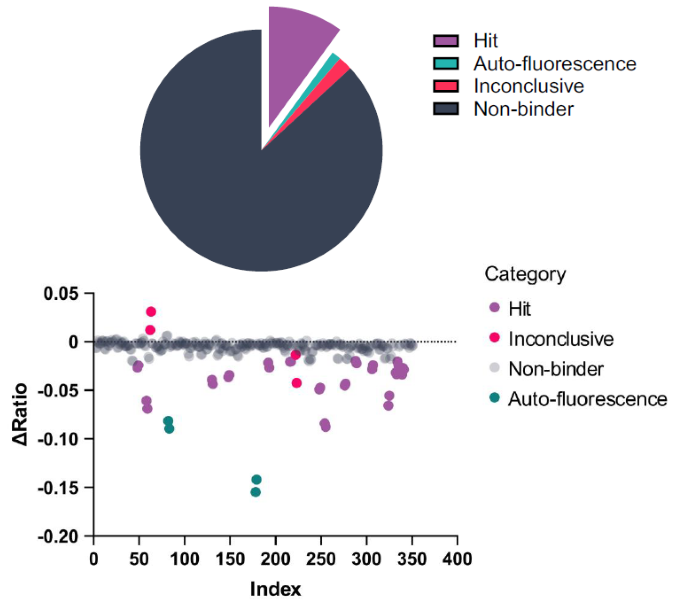
Image Credit: Image courtesy of James Craswell et al., in partnership with ELRIG (UK) Ltd.
Hit validation:
- Affinity determination for the fragments hits was performed
- Three fragments were identified with affinities less than 600 μM and promising ligand efficiencies
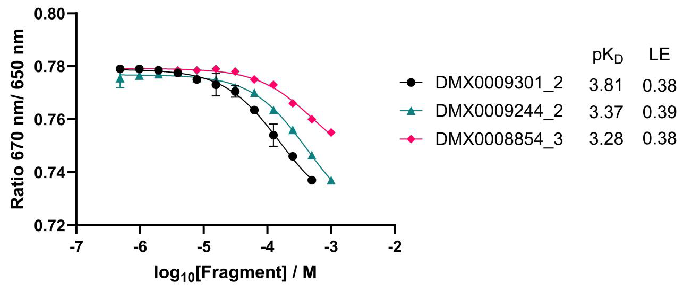
Image Credit: Image courtesy of James Craswell et al., in partnership with ELRIG (UK) Ltd.
Ternary complex formation
- Degrader drugs are heterobifunctional molecules with three components: a protein-of-interest (POI) binding moiety, a linker, and an E3 ubiquitin ligase warhead
- Degraders recruit a POI and an E3 ligase to form a ternary complex that leads to degradation of the POI

Image Credit: Image courtesy of James Craswell et al., in partnership with ELRIG (UK) Ltd.
- Spectral Shift can be used to generate binary affinities, ternary affinities, and alpha values (cooperativity)
- MZ1 and dBET1; degraders that connect a ligand for BRD3-BD2 (or other BRD proteins) and either VHL or CRBN warheads, were used to showcase Spectral Shift
- BRD3 is a member of the Bromodomain and Extra-Terminal motif (BET) protein family and a therapeutic target for various diseases, including cancer
- Cereblon (CRBN) and von Hippel-Lindau (VHL) are commonly utilized E3 ligases in degrader development
- BRD3-BD2, VHL, and CRBN proteins have all been prepared by Domainex for use in this study
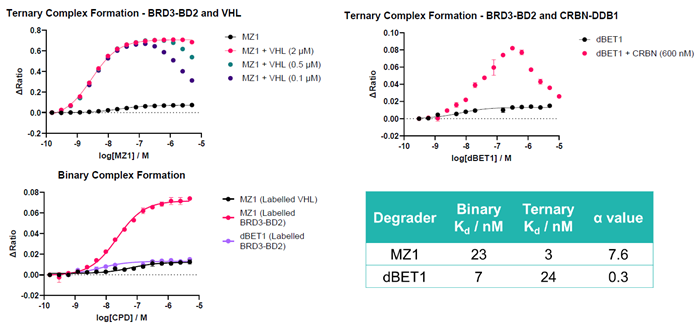
Image Credit: Image courtesy of James Craswell et al., in partnership with ELRIG (UK) Ltd.
Kinase competition assay
Challenge:
- Fluorescently labeling proteins are strategy and construct-dependent
- Labeling can have a destabilizing effect, cause conformational changes, or block binding sites
- The site of the label can limit assay sensitivity
Solution:
- If the direct binding assay is not compatible with the POI, a competition assay could be developed
- Spectral Shift provides an alternative to AlphaLISA, HTRF, and FP
Conclusion:
- A competition assay was successfully developed for ATP-competitive inhibitors for several kinases
- IC50 values within 2-fold of FP values and assay do not have the same drawbacks as FP
Source: ELRIG (UK) Ltd.
.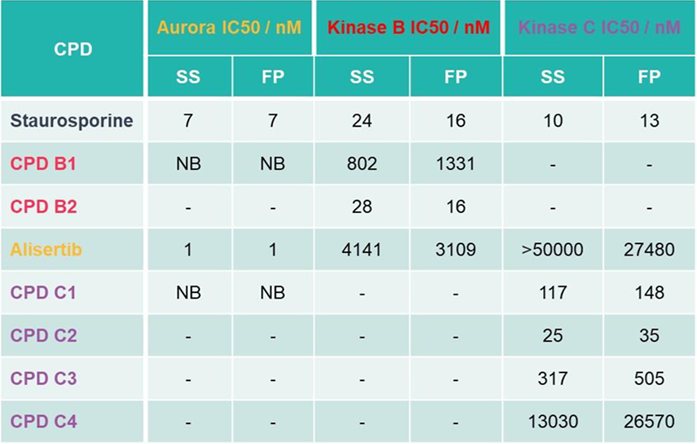
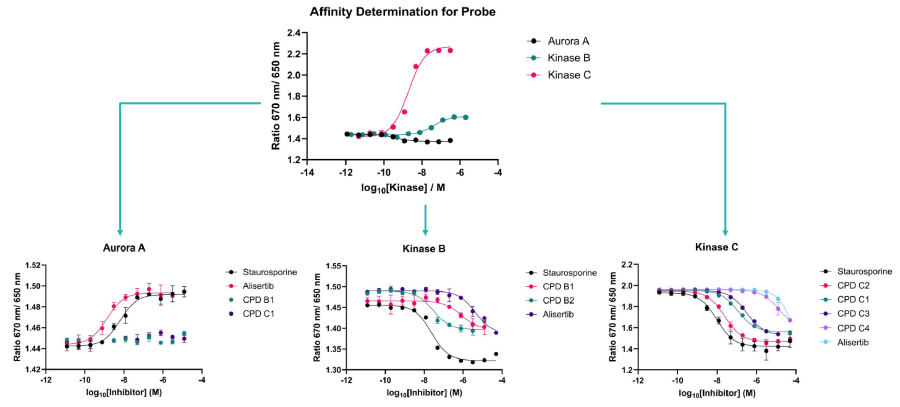
Image Credit: Image courtesy of James Craswell et al., in partnership with ELRIG (UK) Ltd.
Summary
- We believe Domainex performed the first fragment screen with a membrane protein purified in a polymer-encapsulated nanodisc.
- RNA binders have been identified from our fragment library using Spectral Shift
- We have developed TCF assays for the two most common E3 ligases in degrader research.
- A fluorescently labeled competitive inhibitor was used to develop a competition assay, providing an alternative when protein labeling is impossible.
- Domainex can utilize Spectral Shift to support a wide range of drug discovery projects and modalities.
About Domainex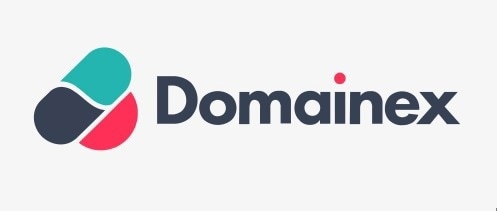
Domainex is a fully integrated drug discovery CRO based near Cambridge, UK. It serves pharmaceutical, biotechnology, academic and patient foundations globally. Domainex’s drug discovery service business was established in 2001 and since that time has continued to expand to serve a wider range of international clients including UCB, FORMA Therapeutics, St George’s University, and The Institute of Cancer Research.
About ELRIG (UK) Ltd.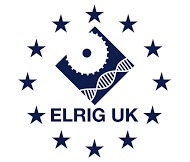
The European Laboratory Research & Innovation Group (ELRIG) is a leading European not-for-profit organization that exists to provide outstanding scientific content to the life science community. The foundation of the organization is based on the use and application of automation, robotics and instrumentation in life science laboratories, but over time, we have evolved to respond to the needs of biopharma by developing scientific programmes that focus on cutting-edge research areas that have the potential to revolutionize drug discovery.
Comprised of a global community of over 12,000 life science professionals, participating in our events, whether it be at one of our scientific conferences or one of our networking meetings, will enable any of our community to exchange information, within disciplines and across academic and biopharmaceutical organizations, on an open access basis, as all our events are free-of-charge to attend!
Our values
Our values are to always ensure the highest quality of content and that content will be made readily accessible to all, and that we will always be an inclusive organization, serving a diverse scientific network. In addition, ELRIG will always be a volunteer led organization, run by and for the life sciences community, on a not-for-profit basis.
Our purpose
ELRIG is a company whose purpose is to bring the life science and drug discovery communities together to learn, share, connect, innovate and collaborate, on an open access basis. We achieve this through the provision of world class conferences, networking events, webinars and digital content.
Sponsored Content Policy: News-Medical.net publishes articles and related content that may be derived from sources where we have existing commercial relationships, provided such content adds value to the core editorial ethos of News-Medical.Net which is to educate and inform site visitors interested in medical research, science, medical devices and treatments.
Last Updated: Nov 18, 2024